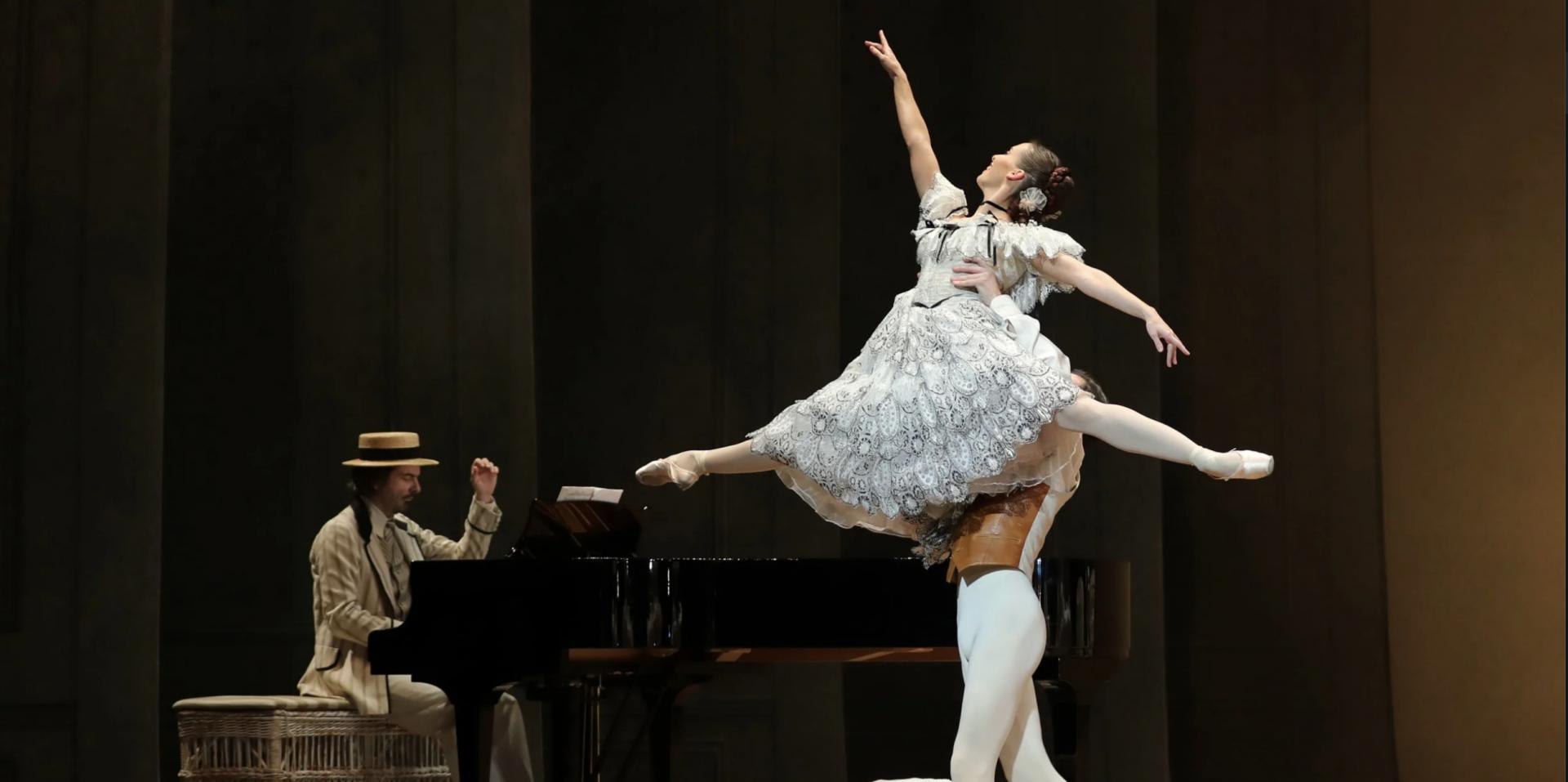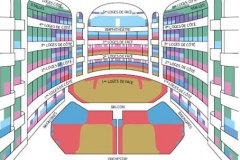The Lady of the Camellias
May 2026 | ||||||
|---|---|---|---|---|---|---|
Mo | Tu | We | Th | Fr | Sa | Su |
The Lady of the Camellias – John Neumeier | Ballet
Ballet in three atcs
After Alexandre Dumas fils
Duration : 2h50 with 2 intervals
She burns with life, attracted by the sparkle of diamonds and the glitter of the balls where Paris’ golden youth whirls and swirls. What is this woman’s name? Marguerite Gautier, the courtesan described by Alexandre Dumas fils in La Dame aux camélias? Or Manon Lescaut, the Abbé Prévost’s heroine?
For choreographer John Neumeier, these two characters are so similar that he intertwines their destinies by introducing a ballet about Manon into his Dame aux camélias. Thanks to this link, he adds a new dimension allowing us to delve deeper into the psychology of the lovers Marguerite and Armand.
To the music of Chopin, intimately interwowen with memories, dreams and reality, the wealth of colours, costumes and ribbons responds to the flood of emotions that overwhelm the characters.
These emotions are shared by the audience, won over by the virtuosity and romanticism of this ballet which entered the Paris Opera repertoire in 2006.
Detail of acts
First part
Prologue
Following the owner’s death, the contents of a luxurious apartment are being disposed of by auction. Between the auctioneer, busy valuing each object, and his assistants, sits Nanina the faithful servant taking leave of the familiar apartment for the last time. Curious visitors, buyers, acquaintances and friends of the deceased enter and examine the surroundings. Among them is an old man, Monsieur Duval. A young man rushes into the room, seemingly lost in thought. It is Armand Duval. Upon realising where he is and seeing the familiar objects around him, he appears to be on the point of collapsing. The old man lovingly supports him. Overcome by memories Armand begins to tell his story.
Act1
It began in the Théâtre des Variétés, during a performance of the ballet Manon Lescaut, the famous drama of a courtesan torn between love of luxury and love itself. Marguerite Gautier, one of the most beautiful and desirable courtesans in Paris, was in the audience. Moved by Manon’s plight she felt close to her, yet refused to accept Manon as her own reflection. Armand, who had admired Marguerite from afar, was introduced to her for the first time that night. Overwhelmed by this meeting, he followed the ballet in a state of extreme anxiety.
Recognising certain of his own traits in the character of Des Grieux, Manon’s faithful lover, he feared for an instant that his own future might reflect Des Grieux’s tragic fate. After the performance Marguerite decided to have fun, in spite of the presence of the boring young Count N., by inviting Gaston, Armand’s friend, and Prudence, a rather vulgar courtesan, to her apartment. Armand came with them. Marguerite used Armand to annoy the count. The situation grew acrimonious. Count N. left the apartment in a fit of jealousy. A coughing fit overcame Marguerite.
Armand followed her and offered his help and, overcome by emotion, confessed his love for her. Marguerite began by sceptically rejecting him yet, at the same time, was touched by his declaration. Subsequently, their relationship deepened. Hurrying from ball to ball, from admirer to admirer, from an ageing duke to a young count, Marguerite continued to lead the same life. But Armand was always waiting for her. He even followed her to the idyllic country house that the Duke, worried by her ill health, had put at her disposal.
Second part
Act 2
In the country, Marguerite continued her turbulent way of life at the Duke’s expense. Inevitably, a public confrontation took place between the Duke and Armand. For the first time Marguerite made a choice, openly defending her lover and rejecting a life of wealth and security. The Duke left indignantly. Their friends left too. Armand and Marguerite, alone at last, could savour their love without hindrance. Overcome by the thought that this happiness is long past, Armand collapses anew. His father, deeply affected, remembers the role that he played in the story. Upon learning of the life that his son was leading, he had visited Marguerite in her country house unbeknown to Armand, and demanded that she left Armand both for the latter’s own good and to protect his daughter’s irreproachable reputation.
Marguerite proved her deep and sincere love for Armand by relinquishing him. Profiting from Armand’s absence, she returned to Paris and threw herself headlong into her old life. Armand regains his calm. He tells his father how he found the house empty on his return. He waited for Marguerite in vain until, to his surprise, Nanina brought him a letter in which Marguerite wrote that she was leaving him to return to her former existence. Unbelieving, he hurried to Paris. After walking all night, he arrived at the apartment to find her in the arms of another man.
Third part
Act 3
Some time later they met by chance on the Champs-Élysées. Marguerite was in the company of a beautiful courtesan, Olympia, to whom Armand immediately paid court, feeling the need to strike back at Marguerite out of his deep sense of hurt. Out of vengeance he began to keep Olympia. Deathly ill, Marguerite visited Armand one last time to beg him to stop humiliating her and to treat her more gently. Their passion burst into flame once more. But a nightmare vision of Manon tortured Marguerite when they fell asleep. On waking, she decided to honour her promise and silently left her beloved Armand for the second time. Later he publicly offended her at a grand ball by handing her an envelope full of money in “payment” for her services. Thereupon Marguerite collapsed.
Armand has now reached the end of his story to which his father, much moved, has listened. They part. Nanina, who has heard Armand arrive, brings him Marguerite’s private diary. Armand starts to read it and learns of the rapid disintegration of her health. He appears to accompany her on her last visit to the theatre to see Manon Lescaut. Manon, banished to America and impoverished, dies of exhaustion in the arms of her faithful lover Des Grieux, who has followed her into exile. Ill and despairing, Marguerite must leave the theatre, but the ballet’s characters pursue her and appear in her feverish dreams alongside her own hopes and memories. She longs to see Armand one last time. Abandoned by her former friends, she entrusts her anxieties and regrets to her diary. She leaves it with Nanina for Armand. Marguerite dies alone and in total poverty.
Program and cast
John Neumeier - Choreography
Frédéric Chopin - Music(1810‑1849)
Markus Lehtinen - Conductor
Michal Bialk - Piano
Frédéric Vaysse-Knitter - Piano
John Neumeier - Adaptation, director
Jürgen Rose - Set design and Costume design
Rolf Warter - Lighting design
With the Paris Opera Étoiles, Premières Danseuses, Premiers Danseurs and Corps de Ballet
The Paris Opera Orchestra
Duration : 2h50 with 2 intervals
Opening
First part - 40 min
Intermission - 20 min
Second part - 40 min
Intermission - 20 min
Third part - 50 min
End
Paris Opera Palace Garnier
RM Europa Ticket GmbH is an officially accredited ticket reseller of/by Opera National de Paris.
Agency number: 4848428
The Paris Opera (French: Opéra de Paris, or simply the Opéra) is the primary opera company of Paris. It was founded in 1669 by Louis XIV as the Académie d'Opéra and shortly thereafter was placed under the leadership of Jean-Baptiste Lully and renamed the Académie Royale de Musique. Classical ballet as we know it today arose within the Paris Opera as the Paris Opera Ballet and has remained an integral and important part of the company. Currently called the Opéra national de Paris, it primarily produces operas at its modern 2700-seat theatre Opéra Bastille which opened in 1989, and ballets and some classical operas at the older 1970-seat Palais Garnier which opened in 1875. Small scale and contemporary works are also staged in the 500-seat Amphitheatre under the Opéra Bastille.
The company's annual budget is in the order of 200 million euros, of which 100 million come from the French state and 70 million from box office receipts. With this money, the company runs the two houses and supports a large permanent staff, which includes the orchestra of 170, a chorus of 110 and the corps de ballet of 150
Each year, the Opéra presents about 380 performances of opera, ballet and other concerts, to a total audience of about 800,000 people (of which 17% come from abroad), which is a very good average seat occupancy rate of 94%In the 2012/13 season, the Opéra presents 18 opera titles (two in a double bill), 13 ballets, 5 symphonic concerts and two vocal recitals, plus 15 other programmes. The company's training bodies are also active, with 7 concerts from the Atelier Lyrique and 4 programmes from the École de Danse.
The Palais Garnier is a 1,979-seat opera house, which was built from 1861 to 1875 for the Paris Opera. It was originally called the Salle des Capucines because of its location on the Boulevard des Capucines in the 9th arrondissement of Paris, but soon became known as the Palais Garnier in recognition of its opulence and its architect, Charles Garnier. The theatre is also often referred to as the Opéra Garnier, and historically was known as the Opéra de Paris or simply the Opéra, as it was the primary home of the Paris Opera and its associated Paris Opera Ballet until 1989, when the Opéra Bastille opened at the Place de la Bastille. The Paris Opera now mainly uses the Palais Garnier for ballet.
The Palais Garnier is "probably the most famous opera house in the world, a symbol of Paris like Notre Dame Cathedral, the Louvre, or the Sacré Coeur Basilica." This is at least partly due to its use as the setting for Gaston Leroux's 1910 novel The Phantom of the Opera and, especially, the novel's subsequent adaptations in films and Andrew Lloyd Webber's popular 1986 musical. Another contributing factor is that among the buildings constructed in Paris during the Second Empire, besides being the most expensive, it has been described as the only one that is "unquestionably a masterpiece of the first rank." This opinion is far from unanimous however: the 20th-century French architect Le Corbusier once described it as "a lying art" and contended that the "Garnier movement is a décor of the grave".
The Palais Garnier also houses the Bibliothèque-Musée de l'Opéra de Paris (Paris Opera Library-Museum). Although the Library-Museum is no longer managed by the Opera and is part of the Bibliothèque nationale de France, the museum is included in unaccompanied tours of the Palais Garnier.

 EN
EN DE
DE IT
IT FR
FR ES
ES RU
RU JP
JP RO
RO
 Seating plan
Seating plan 